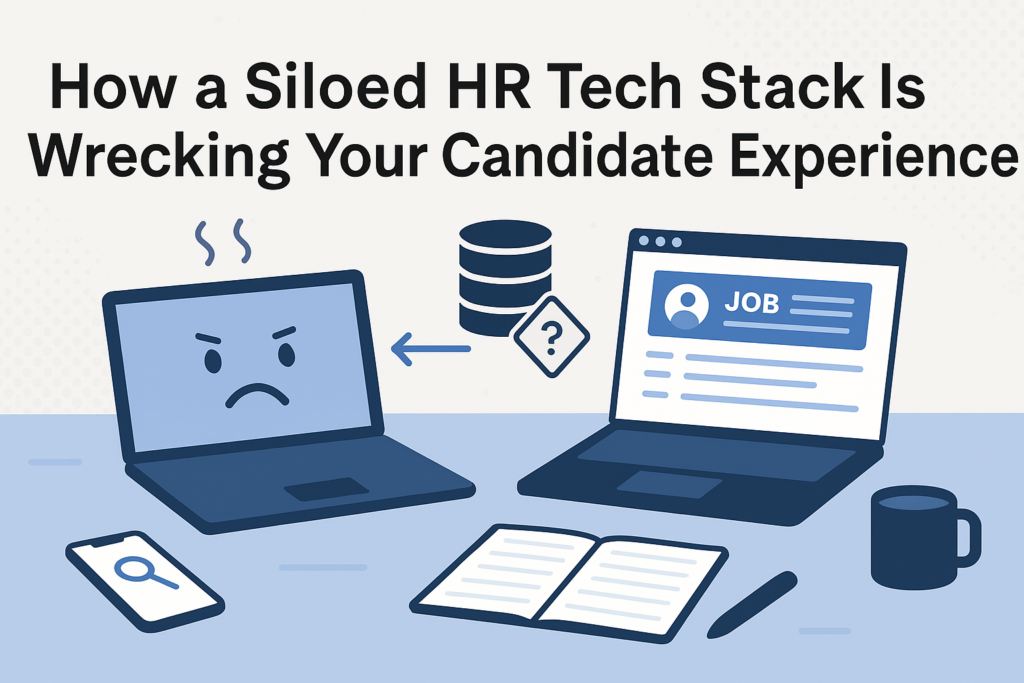- Job Description Process Improvement: How One Workflow Fix Saved 1,200 JDs from Chaos - December 4, 2025
- Affordable Job Description Management Software (That Still Do the Job Right) - November 19, 2025
- AI is Flooding Your Jobs With Unqualified Applicants (We’re Still Figuring Out How to Fix It) - November 18, 2025
You thought you had a tech problem. Turns out, you’ve got a people problem — and a tech stack that doesn’t talk to itself.
I’ve seen it too many times. A recruiter updates a job title in Workday. The change doesn’t show up on the career site. Candidates see conflicting info and bounce. TA blames HR. HR blames IT. And the candidate? They’re already applying somewhere else.
This is what happens when your HR tech stack is siloed. Your ATS, HRIS, CRM, and career site are all running solo instead of playing together like a team. And the candidate experience suffers for it.
Here’s what a broken stack looks like

- Job titles and descriptions that don’t match across platforms
- Outdated listings that still show up in Google search
- Career site pages that take forever to load because they’re pulling from a bad integration
- Manual updates for every job — because automation doesn’t exist or doesn’t work right
If any of this sounds familiar, you’re not alone. One of our customers, a Senior Director of TA at an education tech company, had this exact issue. Multiple divisions were creating job content in silos — with no shared system for templates or branding. The result? A disjointed candidate experience and lots of frustration from marketing, HR, and TA.
We helped them centralize job content using Ongig’s hosted career site and Text Analyzer tools. With Workday integrated in real-time, updates now sync automatically. They no longer have to babysit job posts or worry about broken formatting. The consistency improved dramatically, and they finally have visibility into job content performance — across the board.
Why a siloed HR tech stack kills candidate experience
Here’s what candidates experience when your systems don’t sync:
- Confusion from mixed messages (“Is this remote or not?”)
- Broken links and error messages when clicking Apply
- Inconsistent branding that makes your org look sloppy
- Outdated or duplicated jobs floating around Google Jobs
That last one is a killer. SEO matters — especially when most candidates find jobs through search. If your JD says one thing, but the job card says another, you lose trust. Fast.
The fix: integration and visibility
The good news? This isn’t some massive digital transformation project. It’s about connecting the dots between your tools.
With the right tech stack setup, your team can:
- Push real-time updates from your ATS to your career site
- Lock branding and formatting templates so every JD is consistent
- Get alerts when someone overrides content (like rogue recruiter edits)
- Track performance by job, department, or recruiter
Another persona — a Sr. Talent Program Advisor at a healthcare system — came to us with 4,300+ live job descriptions. Their team of less than 10 was spending 30+ minutes reviewing each one manually. Recruiters were editing content directly in the ATS, causing even more inconsistency.
After switching to Ongig, they used AI-assisted templating and real-time sync to reduce rewrite time to under 5 minutes. Gender bias scores jumped, compliance risks dropped, and hundreds of hours were saved in the first few months alone.
Real-time sync is a game-changer
Let’s say you update your Equal Opportunity language or fix a typo in a job title. Real-time sync means that update goes live everywhere — instantly. No tickets. No copy/paste. No waiting on IT.
That’s not just convenient. It’s compliant. It’s brand-safe. And it saves your team hours of grunt work each week.
Let your tech talk to each other — your candidates will thank you
The HR tech stack isn’t just an internal thing anymore. It’s front and center in the candidate journey. If your systems are disconnected, your brand looks disconnected too. And that can cost you great people.
If your job postings feel like a mess and your career site’s not helping, it’s probably not a content problem. It’s a stack problem.
Why I Wrote This
At Ongig, we work with HR teams every day who feel like they’re duct-taping their tech stack together. It’s frustrating, slow, and risky. We built our tools to fix that — with real-time ATS integration, brand-safe templates, and content performance dashboards that keep everyone aligned. Request a demo and see how Ongig can help your tech stack actually work for you (and your candidates).
FAQs
What is an HR tech stack?
An HR tech stack is the collection of digital tools used for recruiting, hiring, onboarding, and employee management. It typically includes an ATS, HRIS, CRM, and more.
How does ATS integration improve candidate experience?
When your ATS is integrated with your career site and content tools, job postings stay consistent, current, and error-free — making it easier for candidates to apply.
What’s the risk of having siloed HR systems?
Miscommunication, compliance risk, inconsistent branding, and a poor candidate journey — all of which can hurt your hiring funnel.
Can Ongig work with multiple ATS systems?
Yes. We’ve helped organizations integrate and manage job content across multiple ATS platforms seamlessly.
How fast does real-time sync work?
Changes made in the ATS can show up on your live job postings in seconds — no manual updates needed.
